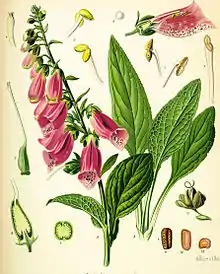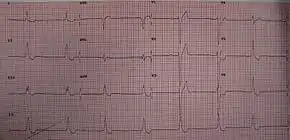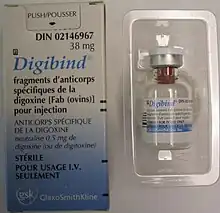| Digoxin toxicity | |
|---|---|
| Other names | Digoxin poisoning, digoxin overdose |
 | |
| Drawings of Digitalis purpurea | |
| Specialty | Emergency medicine |
| Symptoms | vomiting, loss of appetite, confusion, blurred vision, changes in color perception, decreased energy[1] |
| Complications | Heart dysrhythmia[1] |
| Causes | Excessive digoxin, plants such as foxglove[1][2] |
| Risk factors | Low potassium, low magnesium, high calcium[1] |
| Differential diagnosis | Acute coronary syndrome, hyperkalemia, hypothyroidism, beta blocker toxicity[2] |
| Treatment | Supportive care, activated charcoal, atropine, digoxin-specific antibody fragments[2][1] |
| Frequency | ~2,500 cases per year (US)[2] |
Digoxin toxicity, also known as digoxin poisoning, is a type of poisoning that occurs in people who take too much of the medication digoxin or eat plants such as foxglove that contain a similar substance.[1][2] Symptoms are typically vague.[1] They may include vomiting, loss of appetite, confusion, blurred vision, changes in color perception, and decreased energy.[1] Potential complications include an irregular heartbeat, which can be either too fast or too slow.[1]
Toxicity may occur over a short period of time following an overdose or gradually during long-term treatment.[1] Risk factors include low potassium, low magnesium, and high calcium.[1] Digoxin is a medication used for heart failure or atrial fibrillation.[3] An electrocardiogram is a routine part of diagnosis.[2] Blood levels are only useful more than six hours following the last dose.[1]
Activated charcoal may be used if it can be given within two hours of the person taking the medication.[1] Atropine may be used if the heart rate is slow while magnesium sulfate may be used in those with premature ventricular contractions.[2] Treatment of severe toxicity is with digoxin-specific antibody fragments.[1] Its use is recommended in those who have a serious dysrhythmia, are in cardiac arrest, or have a potassium of greater than 5 mmol/L.[1] Low blood potassium or magnesium should also be corrected.[1] Toxicity may reoccur within a few days after treatment.[1]
In Australia in 2012 there were about 140 documented cases.[1] This is a decrease by half since 1994 as a result of decreased usage of digoxin.[1] In the United States 2500 cases were reported in 2011 which resulted in 27 deaths.[2] The condition was first described in 1785 by William Withering.[4]
Signs and symptoms
Digoxin toxicity is often divided into acute or chronic toxicity. In both of these toxicity, cardiac effects are of the greatest concern. With an acute ingestion, symptoms such as nausea, vertigo, and vomiting are prominent. On the other hand, nonspecific symptoms are predominant in chronic toxicity. These symptoms include fatigue, malaise, and visual disturbances.[5]
The classic features of digoxin toxicity are nausea, vomiting, abdominal pain, headache, dizziness, confusion, delirium, vision disturbance (blurred or yellow vision). It is also associated with cardiac disturbances including irregular heartbeat, ventricular tachycardia, ventricular fibrillation, sinoatrial block and AV block.[6]
Diagnosis
In individuals with suspected digoxin toxicity, a serum digoxin concentration, serum potassium concentration, creatinine, BUN, and serial electrocardiograms is obtained.[7]
ECG

In digoxin toxicity, the finding of frequent premature ventricular beats (PVCs) is the most common and the earliest dysrhythmia. Sinus bradycardia is also very common. In addition, depressed conduction is a predominant feature of digoxin toxicity. Other ECG changes that suggest digoxin toxicity include bigeminal and trigeminal rhythms, ventricular bigeminy, and bidirectional ventricular tachycardia.[5]
Blood test
The level of digoxin for treatment is typically 0.5-2 ng/mL.[8] Since this is a narrow therapeutic index, digoxin overdose can happen. A serum digoxin concentration of 0.5-0.9 ng/mL among those with heart failure is associated with reduced heart failure deaths and hospitalizations.[9] It is therefore recommended that digoxin concentration be maintained in approximately this range if it is used in heart failure patients.
High amounts of the electrolyte potassium (K+) in the blood (hyperkalemia) is characteristic of digoxin toxicity.[6] Digoxin toxicity increases in individuals who have kidney impairment. This is most often seen in elderly or those with chronic kidney disease or end-stage kidney disease.[10]
Treatment

The primary treatment of digoxin toxicity is digoxin immune fab, which is an antibody made up of anti-digoxin immunoglobulin fragments. This antidote has been shown to be highly effective in treating life-threatening signs of digoxin toxicity such as hyperkalemia, hemodynamic instability, and arrhythmias.[11] Fab dose can be determined by two different methods. First method is based on the amount of digoxin ingested whereas the second method is based on the serum digoxin concentration and the weight of the person.[10]
Other treatment that may be used to treat life-threatening arrhythmias until Fab is acquired are magnesium, phenytoin, and lidocaine. Magnesium suppresses digoxin-induced ventricular arrhythmias while phenytoin and lidocaine suppresses digoxin-induced ventricular automaticity and delay afterdepolarizations without depressing AV conduction. In the case of an abnormally slow heart rate (bradyarrhythmias), Atropine, catecholamines (isoprenaline or salbutamol), and/or temporary cardiac pacing can be used.[8]
References
- 1 2 3 4 5 6 7 8 9 10 11 12 13 14 15 16 17 18 19 Pincus, M (February 2016). "Management of digoxin toxicity". Australian Prescriber. 39 (1): 18–20. doi:10.18773/austprescr.2016.006. PMC 4816869. PMID 27041802.
- 1 2 3 4 5 6 7 8 Palatnick, W; Jelic, T (February 2014). "Emergency department management of calcium-channel blocker, beta blocker, and digoxin toxicity". Emergency Medicine Practice. 16 (2): 1–19, quiz 19–20. PMID 24883458. Archived from the original on 2014-05-14.
- ↑ Gheorghiade, M; van Veldhuisen, DJ; Colucci, WS (30 May 2006). "Contemporary use of digoxin in the management of cardiovascular disorders". Circulation. 113 (21): 2556–64. doi:10.1161/circulationaha.105.560110. PMID 16735690.
- ↑ Feldman, Arthur M. (2008). Heart Failure: Pharmacologic Management. John Wiley & Sons. p. 26. ISBN 9781405172530. Archived from the original on 2017-09-10.
- 1 2 Ma, G; Brady, WJ; Pollack, M; Chan, TC (February 2001). "Electrocardiographic manifestations: digitalis toxicity". The Journal of Emergency Medicine. 20 (2): 145–52. doi:10.1016/s0736-4679(00)00312-7. PMID 11207409.
- 1 2 Eichhorn, EJ; Gheorghiade, M (2002). "Digoxin". Progress in Cardiovascular Diseases. 44 (4): 251–66. doi:10.1053/pcad.2002.31591. PMID 12007081.
- ↑ Dugdale, David. "Digitalis toxicity". MedlinePlus. Archived from the original on 1 November 2014. Retrieved 30 October 2014.
- 1 2 Bhatia, SJ (July 1986). "Digitalis toxicity--turning over a new leaf?". The Western Journal of Medicine. 145 (1): 74–82. PMC 1306817. PMID 3529634.
- ↑ Ahmed, A; Rich, MW; Love, TE; Lloyd-Jones, DM; Aban, IB; Colucci, WS; Adams, KF; Gheorghiade, M (January 2006). "Digoxin and reduction in mortality and hospitalization in heart failure: a comprehensive post hoc analysis of the DIG trial". European Heart Journal. 27 (2): 178–86. doi:10.1093/eurheartj/ehi687. PMC 2685167. PMID 16339157.
- 1 2 Yang, EH; Shah, S; Criley, JM (April 2012). "Digitalis toxicity: a fading but crucial complication to recognize". The American Journal of Medicine. 125 (4): 337–43. doi:10.1016/j.amjmed.2011.09.019. PMID 22444097. S2CID 7538601.
- ↑ Antman, EM; Wenger, TL; Butler VP, Jr; Haber, E; Smith, TW (June 1990). "Treatment of 150 cases of life-threatening digitalis intoxication with digoxin-specific Fab antibody fragments. Final report of a multicenter study". Circulation. 81 (6): 1744–52. doi:10.1161/01.cir.81.6.1744. PMID 2188752.